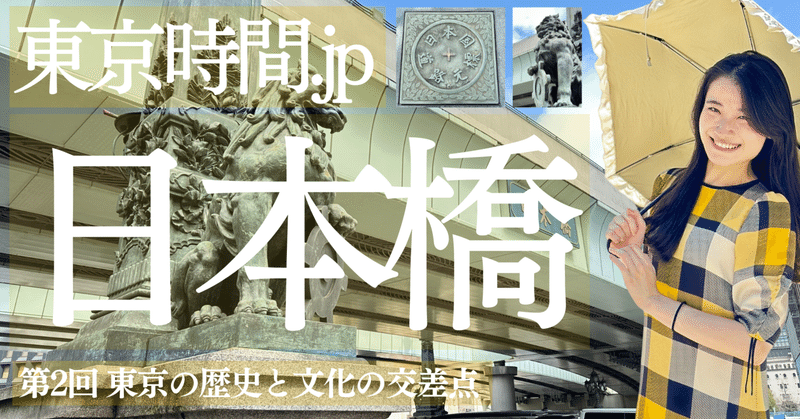
【東京時間.jp】第2回 日本橋:東京の歴史と文化の交差点
東京の心臓部に位置する日本橋は、江戸時代に徳川家康の都市計画における象徴的な存在でした。1603年の江戸幕府の開設と同時に架けられた木造の橋は、東京の玄関口として、経済と文化の中心地へと発展しました。400年以上の時を経ても、この地は国内外を問わず、日本の経済、文化、交通の要として重要な役割を担い続けています。


江戸五街道の起点である日本橋は、全国からの旅人や商人、武士など、さまざまな人々が行き交う賑わいを見せました。当時、問屋や質屋、両替商など多くの商家や宿場町が並び、物流と金融の中心地として、江戸の経済発展に大きく貢献しました。また、人々の憩いの場であり、文化の発信地としても機能していました。歌舞伎や能、落語などの伝統芸能が生まれ、茶室や芸術作品の創出の場ともなりました。

本物は道路中央

1868年の明治維新を経て、日本は近代国家への一歩を踏み出しました。新しい西洋文化の導入と共に、日本橋周辺も徐々に変化しました。当時完成した石造りの二連アーチ橋は、伝統と新技術の融合を象徴するものとして、この変化を代表します。西洋のデザインと日本の美意識の融合は、単なる交通の要所としてだけでなく、技術と芸術が共存する場所としての意義を示しています。明治時代、この地域は西洋製品や思想を日本全国に伝える窓口として機能し、近代化の推進役となりました。

戦時下や戦後の混乱期、高度経済成長期を経て、一時は日本橋の街並みが失われ、都市構造も大きく変わりました。しかし、平成に入ると、歴史的建造物の復元や文化遺産の保護に向けた取り組みが本格化しました。1999年には日本橋自体が、その美しさと技術の高さから国の重要文化財に指定されるなど、江戸時代の面影を残す地域資源の継承が重視されるようになりました。


麒麟と獅子といった東洋的なモチーフを採用

今までの麒麟の作品には見られない羽を付けることを決めた
21世紀に入り、再開発が進む日本橋周辺では、過去の遺産と現代の革新が共存する新たな街並みが形成されつつあります。高層ビルが立ち並ぶ一方で、かつての道を偲ばせる石畳の小路も点在し、そこでは老舗の和菓子店や商家が営業を続けています。伝統と最新のビジネスが融合する、生き生きとした街並みが広がっています。橋そのものの建て替えも、現代的なアーチに江戸時代の特徴を取り入れたデザインであり、両者の調和を目指しています。こうした特色が、日本橋が過去から現代に至るまで受け継がれてきた精神性や技術の粋を体現する空間であることを示しています。

日本橋を訪れることは単に名所を巡る以上の価値ある体験を意味します。この地を歩くと、江戸時代から現代に至るまで、人々の生活の足跡に触れることができます。老舗店での伝統的な職人技や、寺社仏閣や史跡からは、日本人の精神性の源流を感じ取ることができるでしょう。伝統と新しさが出会う場としての日本橋は、日本文化の多層性と進化を体験できる格別な空間です。

そして何より、日本橋を訪れることは、日本の過去と、これから目指すべき方向性を考える貴重な機会を提供します。過去の遺産を尊重しつつ、新しい文化を創造する調和がここから見えます。経済活動の面でも、進化を続けながら、独自の価値観が息づいていることが感じられるはずです。日本橋は、江戸時代から受け継がれた精神性と、国際都市としての開かれた姿勢が共存する場所です。この地を訪れることは、日本文化の本質と新たな可能性に思いを馳せる、まさに旅そのものです。

東京の中心でありながら、歴史や文化、人々の生活の憩いの場としての側面を併せ持つ日本橋。この地域を訪れることで、私たちは日本の魂の深さと、斬新な変革の萌芽に出会えます。日本橋は、日本文化の源流であり、その本質に触れられる魅力溢れる場所です。
Nihonbashi: A Crosspoint of Tokyo's History and Culture
Situated at the heart of Tokyo, Nihonbashi was a symbolic presence in Tokugawa Ieyasu's urban planning during the Edo period. Constructed concurrently with the establishment of the Edo shogunate in 1603, the wooden bridge of Nihonbashi served as Tokyo's gateway, evolving into a center of economy and culture. Over 400 years later, this area continues to play a crucial role in Japan's economy, culture, and transportation, both domestically and internationally.
Located at the starting point of the Edo Five Routes, Nihonbashi was bustling with travelers, merchants, and samurai from across the country. Back then, numerous merchants, pawnshops, and money changers lined the streets, contributing significantly to Edo's economic development as a hub of logistics and finance. It also served as a place of rest and cultural dissemination, where traditional performing arts like Kabuki, Noh, and Rakugo were born, and tea houses and artistic creations flourished.
After the Meiji Restoration in 1868, Japan took its first steps towards becoming a modern nation. With the introduction of new Western cultures, the Nihonbashi area gradually transformed. The completion of the stone double-arch bridge at that time symbolized the fusion of tradition and new technology, representing this change. The blend of Western design and Japanese aesthetic not only served as a pivotal transportation point but also as a testament to the coexistence of technology and art. In the Meiji era, this area functioned as a gateway for spreading Western products and ideas throughout Japan, playing a leading role in modernization.
Through wartime, post-war turmoil, and the high economic growth period, the streetscape of Nihonbashi was temporarily lost, and the city's structure underwent significant changes. However, with the advent of the Heisei era, efforts towards the restoration of historical buildings and the protection of cultural heritage intensified. In 1999, Nihonbashi itself was designated as an important cultural property of the country for its beauty and technical excellence, emphasizing the inheritance of regional resources that retain the Edo period's ambiance.
Entering the 21st century, the Nihonbashi area undergoing redevelopment is forming a new streetscape where the legacy of the past coexists with modern innovation. While skyscrapers line the area, cobblestone alleys reminiscent of old roads are scattered around, with longstanding confectionery stores and merchants continuing their business. This lively streetscape, where tradition and cutting-edge business intertwine, is spreading. The redesign of the bridge itself, incorporating Edo period characteristics into a modern arch, aims for harmony between the two, showcasing the area as a space embodying the essence of spirituality and technology passed down from the past to the present.
Visiting Nihonbashi means more than just touring famous sites; it offers a valuable experience. Walking through this area allows one to encounter the traces of life led by people from the Edo period to today. Traditional craftsmanship observed in longstanding stores, and temples, shrines, and historical sites evoke thoughts of the origins of the Japanese spirit. As a meeting point of tradition and novelty, Nihonbashi provides a unique space where one can experience the complexity and evolution of Japanese culture.
Above all, visiting Nihonbashi offers a great opportunity to reflect on Japan's past and the direction it should aim for in the future. The harmony between preserving historical heritage and creating new culture is evident here. In terms of economic activities, one can sense the continuous evolution while recognizing the unique values that run deep in the Japanese lineage. Nihonbashi stands as a place where the spirituality passed down since the Edo period and the pioneering values of an international city coexist. Visiting this area is akin to embarking on a journey that contemplates the fundamental aspects of Japanese culture and its new possibilities.
Being at the center of Tokyo, Nihonbashi holds the aspects of history, culture, and a space for people's lives and relaxation. By visiting this area, we encounter the profound soul of Japan and the sprouts of innovative change. Nihonbashi is indeed a source of Japanese culture, offering an opportunity to touch its essence, making it a fascinating place.
この記事が気に入ったらサポートをしてみませんか?
